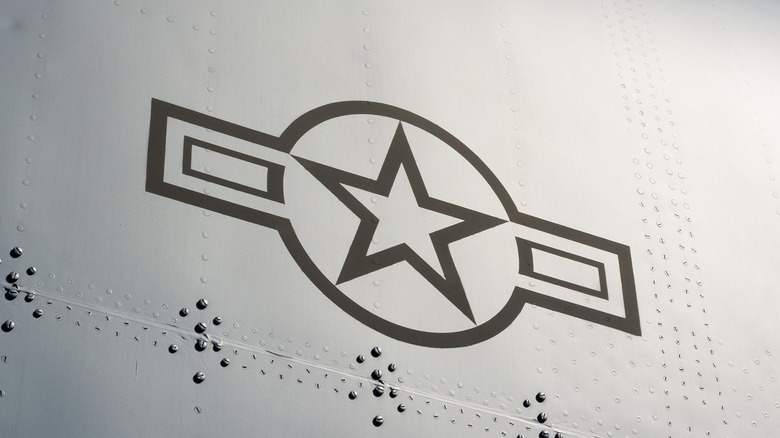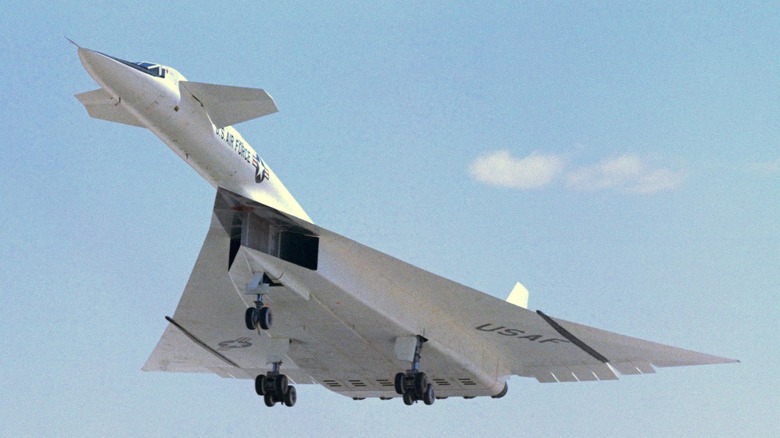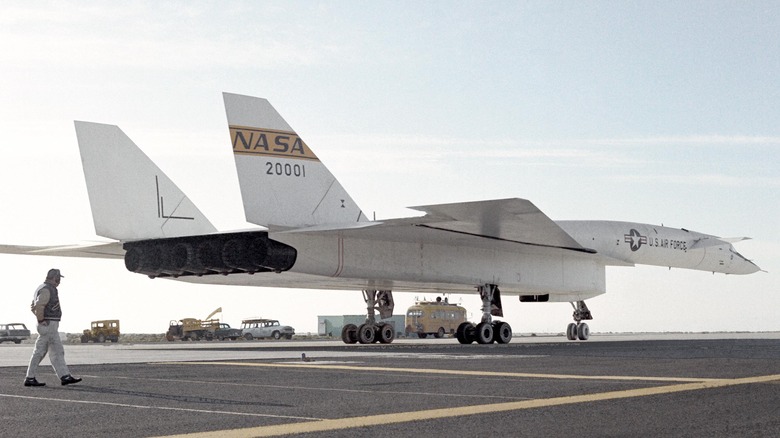The Incredible Supersonic Bomber Designed To Outrun Any Soviet Aircraft
The 1950s was a unique period for U.S. strategic defense. It was, of course, a post-nuclear world, one in which nuclear weapons had proliferated on multiple continents. But it was also a time that predated the nuclear triad — a country's ability to launch a nuclear strike by air, sea, and land-based delivery systems. In a frantic push to develop always-more-capable first strike and retaliatory strike capabilities, an arms race ensued that churned out some pretty wild ideas and technologies. One such example is the XB-70 Valkyrie nuclear strike bomber.
As reported by Mustard in the video below, the two strategic bombers in the U.S. arsenal at the end of the 1950s were the B-52 Stratofortress and the B-58 Hustler. The B-52 had an incredible range of 8,800 miles, which is more than enough to reach the former Soviet Union — the main adversary for the U.S. during the Cold War — but it was much too slow to get past Soviet interceptors. The Hustler, on the other hand, was plenty fast with a max speed of Mach 2, but its limited range meant it couldn't penetrate very far into Soviet airspace.
The U.S. Air Force (USAF) needed a new strategic bomber, one that could operate at long range while outrunning enemy fighter planes and carrying a large nuclear payload. It was North American Aviation — now a part of The Boeing Company — that designed and ultimately built the XB-70 Valkyrie, the largest and heaviest airplane to ever fly at speeds exceeding Mach 3.
A plane ahead of its time
The Valkyrie was a marvel of technical innovation. It could sustain speeds of over 2,000 miles per hour with its six inline turbojet engines with afterburners. Its range was more than 4,000 miles, and it could carry a payload weight of up to 50,000 pounds. Remarkably, the fully-loaded plane weighed in at 542,000 pounds, according to Boeing. And while the plane operated above 70,000 feet, the cabin was pressurized, meaning the flight crew didn't need to wear special pressure suits like the crews of the SR-71 Blackbird — which would operate at similar speeds and altitudes a decade later — so Valkyries could be quickly scrambled.
The plane traveled so quickly that the air friction caused its outer skin to heat up to incredible temperatures. Engineers had to avoid traditional airplane construction methods and materials, instead opting for a brazed honeycomb of stainless steel and titanium, and fuel was repurposed as coolant and circulated throughout the structure to absorb heat.
But the most advanced feature of the Valkyrie was perhaps its wings. Because the plane flew faster than the speed of sound, it generated shockwaves as it tore through the atmosphere. The Valkyrie's innovation was to have wings whose outer third could fold down and in up to 65 degrees. Parts of the shockwave then bounced off the wing and back up against the body of the plane, providing additional lift.
Ride of the Valkyries
While the Valkyrie was under development during the 1960s, advances in missile technology began to fill the niche of long-range nuclear strategic bombers. Meanwhile, the prototype Valkyrie suffered a series of delays as issues began to pile up. Both before and after initial flight tests, engineers encountered challenges that required costly redesigns.
But things weren't all bad: the Valkyrie was a cutting-edge aircraft and the challenges that it created offered valuable insights into aircraft design and construction. In fact, it was at this point that NASA partnered with the USAF on the project, agreeing to use the Valkyrie to gather information about supersonic flight. With the lessons learned from the prototype aircraft, a second Valkyrie was built, and to its credit, it performed much better.
Unfortunately, the second Valkyrie was lost in a midair collision with an F-104 Starfighter during a photo flight when the Starfighter was caught in the Valkyrie's wake. One Valkyrie pilot was able to eject, though he sustained serious injuries, but the second Valkyrie crewmember and the Starfighter pilot both tragically lost their lives in the disaster. The prototype Valkyrie continued to be flown by NASA for research until 1969, and no others were ever produced. It's now housed at the National Museum of the United States Air Force near Dayton, Ohio.


